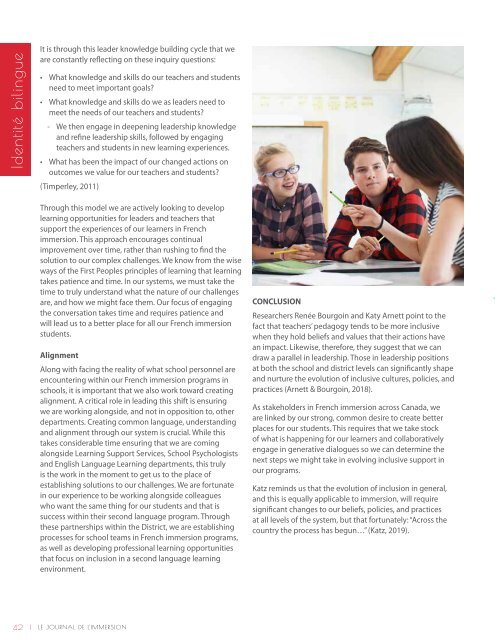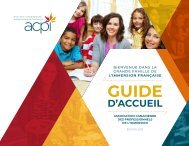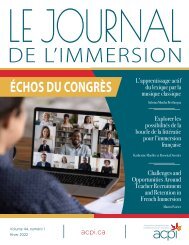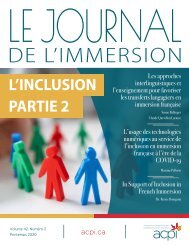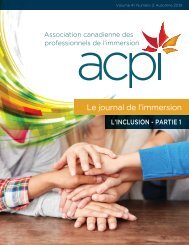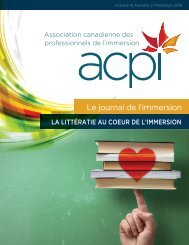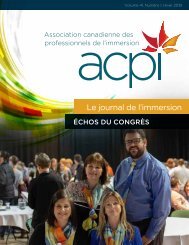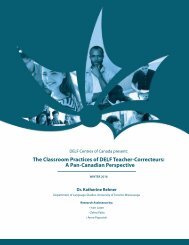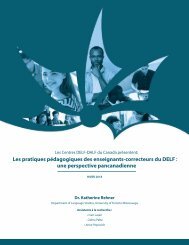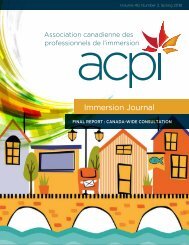Vol_43_n2_web_f
You also want an ePaper? Increase the reach of your titles
YUMPU automatically turns print PDFs into web optimized ePapers that Google loves.
Identité bilingue<br />
Identité bilingue<br />
It is through this leader knowledge building cycle that we<br />
are constantly reflecting on these inquiry questions:<br />
• What knowledge and skills do our teachers and students<br />
need to meet important goals?<br />
• What knowledge and skills do we as leaders need to<br />
meet the needs of our teachers and students?<br />
- We then engage in deepening leadership knowledge<br />
and refine leadership skills, followed by engaging<br />
teachers and students in new learning experiences.<br />
• What has been the impact of our changed actions on<br />
outcomes we value for our teachers and students?<br />
(Timperley, 2011)<br />
Through this model we are actively looking to develop<br />
learning opportunities for leaders and teachers that<br />
support the experiences of our learners in French<br />
immersion. This approach encourages continual<br />
improvement over time, rather than rushing to find the<br />
solution to our complex challenges. We know from the wise<br />
ways of the First Peoples principles of learning that learning<br />
takes patience and time. In our systems, we must take the<br />
time to truly understand what the nature of our challenges<br />
are, and how we might face them. Our focus of engaging<br />
the conversation takes time and requires patience and<br />
will lead us to a better place for all our French immersion<br />
students.<br />
Alignment<br />
Along with facing the reality of what school personnel are<br />
encountering within our French immersion programs in<br />
schools, it is important that we also work toward creating<br />
alignment. A critical role in leading this shift is ensuring<br />
we are working alongside, and not in opposition to, other<br />
departments. Creating common language, understanding<br />
and alignment through our system is crucial. While this<br />
takes considerable time ensuring that we are coming<br />
alongside Learning Support Services, School Psychologists<br />
and English Language Learning departments, this truly<br />
is the work in the moment to get us to the place of<br />
establishing solutions to our challenges. We are fortunate<br />
in our experience to be working alongside colleagues<br />
who want the same thing for our students and that is<br />
success within their second language program. Through<br />
these partnerships within the District, we are establishing<br />
processes for school teams in French immersion programs,<br />
as well as developing professional learning opportunities<br />
that focus on inclusion in a second language learning<br />
environment.<br />
CONCLUSION<br />
Researchers Renée Bourgoin and Katy Arnett point to the<br />
fact that teachers’ pedagogy tends to be more inclusive<br />
when they hold beliefs and values that their actions have<br />
an impact. Likewise, therefore, they suggest that we can<br />
draw a parallel in leadership. Those in leadership positions<br />
at both the school and district levels can significantly shape<br />
and nurture the evolution of inclusive cultures, policies, and<br />
practices (Arnett & Bourgoin, 2018).<br />
As stakeholders in French immersion across Canada, we<br />
are linked by our strong, common desire to create better<br />
places for our students. This requires that we take stock<br />
of what is happening for our learners and collaboratively<br />
engage in generative dialogues so we can determine the<br />
next steps we might take in evolving inclusive support in<br />
our programs.<br />
Katz reminds us that the evolution of inclusion in general,<br />
and this is equally applicable to immersion, will require<br />
significant changes to our beliefs, policies, and practices<br />
at all levels of the system, but that fortunately: “Across the<br />
country the process has begun…” (Katz, 2019).<br />
References<br />
ARNETT, K., & BOURGOIN, R. (2018). Access for success: making inclusion work for language learners. North York, ON: Pearson Canada.<br />
COOK, V. (2009). The goals of ELT: reproducing native-speakers or promoting multi-competence among L2 users? Textos do Seminário (pp. 9-22):<br />
http://www.viviancook.uk/Writings/Papers/EFLGoals.htm<br />
COUNCIL OF EUROPE / CONSEIL DE L’EUROPE (2021). Self-assessment grid English. Retrieved from Common European Framework of Reference for<br />
Languages: https://rm.coe.int/CoERMPublicCommonSearchServices/DisplayDCTMContent?documentId=090000168045bb52 CUMMINS, J. (2014).<br />
Education matters, 2(1), 36<br />
GROSJEAN, F. (2002, February). Interview on bilingualism (Judit Navracsics, interviewer). Hungary: Veszprem University. Retrieved April 2021, from<br />
https://www.francoisgrosjean.ch/interview_2002_en.html<br />
KASER, L., & HALBERT, J. (2017). The spiral playbook: leading with an inquiring mindset in school systems and schools. C21 Canada.<br />
KATZ, J. (2019). Teaching to diversity: The Three Block Model of Universal Design for Learning (UDL). Retrieved from http://www.threeblockmodel.com/thethree-block-model-of-udl.html<br />
MADY, C., & MASSON, M. (2018). Principals’ beliefs about language learning and inclusion of English language learners. Canadian Journal of Applied<br />
Linguistics / Revue canadienne de linguistique appliquée, 21(1), 71-93. Retrieved 04-06-2021, from https://www.erudit.org/en/journals/cjal/2018-v21-n1-<br />
cjal03922/1050811ar.pdf<br />
MADY, C., & THOMAS, R. (2014). Teaching for transfer: insights from theory and practices in primary-level French-second-language classrooms /<br />
« Enseigner en vue d’un transfert : aperçus théorique et pratique en classes de français langue seconde au primaire ». McGill Journal of Education / Revue<br />
des sciences de l’éducation de McGill, 49(2), 277-519. Retrieved from Érudit: https://mje.mcgill.ca/article/download/9101/6964/28534<br />
MOORE, S. (2018). Five Moore minutes, episode 1- The evolution of inclusion! The past and future of education. Vancouver. Retrieved from<br />
https://www.youtube.com/watch?v=PQgXBhPh5Zo<br />
TIMPERLEY, H. (2011). Realizing the power of professional learning Maidenhead, UK: McGraw Hill.<br />
WISE, N. (2015, April 15). French Immersion should be for all. Retrieved from National Post: https://nationalpost.com/opinion/nancy-wise-frenchimmersion-should-be-for-all<br />
Gagnants<br />
grâce au<br />
français : où<br />
en sont-ils?<br />
Découvrez des histoires<br />
inspirantes de diplômés en<br />
français langue seconde.<br />
Comment l’apprentissage<br />
du français vous a<br />
aidé à façonner votre<br />
cheminement personnel<br />
ou professionnel?<br />
Partagez votre<br />
histoire avec nous!<br />
ouensontils.ca<br />
Un projet de<br />
cpf.ca<br />
ANAHAREO DOELLE<br />
POSITION • JOB TITLE<br />
Spécialiste aérienne avec le cirque Wonderbolt • Aerial speciali<br />
PROGRAMME • PROGRAM<br />
42 | LE JOURNAL DE L'IMMERSION<br />
<strong>Vol</strong>. <strong>43</strong>, Immersion n o 2, été française 2021 •<br />
ANAAR KARA French | <strong>43</strong>Immersio


